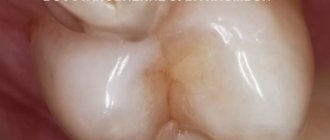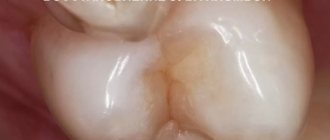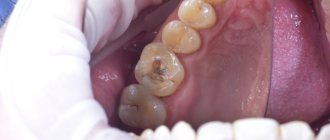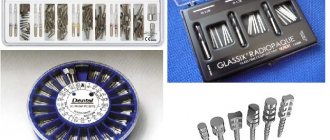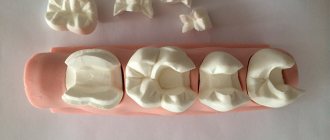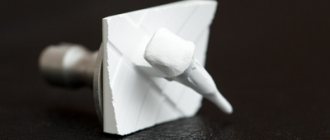Note! ARTE-S Center offers patients high quality ceramics. The clinic has a reasonable pricing policy, so our prices are affordable. Our specialists will eliminate any damage.
A ceramic tooth inlay is better than a conventional filling material, so patients prefer the new design, as it is more technologically advanced and is made using an individual impression.
How does an inlay differ from a filling?
If you compare the functionality and appearance of the insert with native units, there are practically no differences between them. Therefore, microprostheses are actively used for frontal and chewing teeth. It is done personally for each patient. Some believe that the insert is a type of filling. In fact, its parameters are incomparably higher than even modern filling material. This becomes clear if we consider the pros and cons of ceramic inlays. Among the positive qualities it is worth highlighting:
- Increased strength.
- Providing significant strength to unit surfaces.
- High levels of aesthetics. The design is translucent, which accurately imitates a real crown.
- Durability, which is several times longer than the service life of fillings. The inserts retain their original shade for a long time and are resistant to staining.
As for the disadvantages, the system is expensive. This is due to the difficult production of products. True, taking into account all the advantages, the current price is completely justified. It is much lower than that of prostheses. Ceramic inserts are the most successful and aesthetic alternative to both artificial crowns and fillings. They are many times stronger and much more beautiful!
What is a filling?
A filling is the restoration of a tooth defect formed after treatment of caries or other tooth damage using filling materials.
In dentistry, there are many filling materials that can replace such defects. Today, the most practical to use are photocomposites (light-curing filling materials). Despite their advantages, fillings also have disadvantages that significantly reduce the lifespan of a tooth:
- shrinkage during light curing,
- chipping of the thin walls of the filling,
- instability to external influences - darken over time, color changes due to exposure to tobacco, coffee and other dyes.
Guided by these shortcomings, the use of fillings in case of large damage is inappropriate. In such situations, the most optimal solution would be to use tabs.
In what cases is it recommended instead of a filling?
When the situation cannot be saved by conventional filling, they resort to fragments of dental units that completely cover the defect. They give organs their original shape and protect them from future destruction. Also, the structure can become a support on which the crown is placed. Ceramic inlays instead of fillings are recommended:
- If the patient has a high degree of sensitivity of the units, due to which the teeth of the opposite side quickly wear out;
- When the patient has mechanical damage to the enamel;
- In case the unit will act as a support for the prosthesis;
- With tooth destruction from a third to 60%;
- If you need to replace large old fillings;
- When a patient has a large cavity formed in a tooth due to caries;
- During root canal treatment;
In fact, the insert is a kind of filling. But inserts are made in the laboratory, and they are used to restore even large-scale damage, when the filling will not hold due to a large void.
When salvation is a crown
A dental inlay is a way to save a tooth when it is not possible to fill it. If the damage is significant, then a filling or inlay will not help; more reliable protection will be required - a crown
.
Modern designs are durable and help maintain quality of life when 50% or more
of tooth tissue is lost.
Restoring a tooth with a crown (the price is calculated depending on the chosen material) is reliable protection against recurrent caries. Microparticles of food do not get under the crown, pathogenic microflora do not penetrate, and there is no violation of the marginal seal.
Ceramic, metal-ceramic or zirconium crowns on a tooth will become a reliable covering for the thinned, fragile walls of a natural tooth and will protect them from chipping or breaking.
Modern dentistry makes it possible to bring the shade of the crown as close as possible to the natural shade of the enamel, so the presence of the structure is almost invisible. Installing crowns on chewing teeth is an opportunity not to limit your diet, to eat familiar foods without fear of destruction of the teeth.
Types of ceramic inlays
By type, insertion structures are divided into restorative (changing the color and shape of units) and stump structures, which are intended for restoration work on the coronal part. The latest achievement in aesthetic dentistry is the E Max ceramic inlay. It is widely used in European countries. This system is all-ceramic. Its frame consists of zirconium dioxide or glass ceramics. Inserts are divided into groups and according to the composition of materials.
Metal ceramics
Products made from metal ceramics marked a new era in orthodontics. Their tariffs are almost identical to ceramic systems, but the quality is very poor. Such liners may fall out because they are afraid of high temperatures due to the thermal expansion of steel. Therefore, specialists in each individual case determine the material from which the insert will be made.
Pressed ceramics
When an old filling is removed, it is necessary to choose a material that will serve the patient for a long time and will not cause discomfort. In such cases, they often resort to installing pressed ceramic products. The procedure for creating such an insert is very complicated. First, the porcelain is processed through extremely high temperatures and significant pressure. This processing makes it possible to obtain a very durable and strong material – pressed ceramics. With the help of structures made from this material, the most acceptable aesthetic indicators are achieved. However, the strength of such a system is somewhat inferior to similar products made from zirconium.
Zirconium dioxide
If previous products were created from one material or another, then zirconium inserts involve processing ready-made, that is, already created, blanks. Grinding is performed on a pre-made impression of the teeth, or rather, on a modern-made plaster model. Moreover, all this is done in an automatic process under electronic control. The workpiece must be thoroughly fired. Its cavity is filled with a special porcelain substance. Subsequently, the insert, which has already hardened, is attached to the unit that is damaged.
A comparative description of porcelain and zirconium products showed that in terms of external indicators they are practically no different. As for the frame made of zirconium, it has identical strength characteristics to metal structures. Of course, the process of creating an orthodontic device is important. In this case, the entire process is automated, which means that the influence of the human factor is excluded. Of course, this is a huge advantage.
What is a tab?
A ceramic inlay is a microprosthetic tooth, which is manufactured in a laboratory method, with the help of which the defect of a damaged tooth is corrected, by giving it its previous shape, and the tooth is also protected from further destruction.
Ceramics most accurately conveys the properties of enamel - in terms of strength, color, light reflection, etc., and does not cause any allergic reactions or color changes. Guided by these qualities, in case of large defects, it is advisable to replace such damage with a ceramic inlay rather than a filling.
Advantages of a ceramic inlay over a filling
- have greater strength and higher wear resistance than fillings. Significantly strengthens the tooth.
- superior in aesthetic aspect. Ceramics have translucency, which allows you to completely match the color of the tooth.
- resistant to external influences. Over time, their color does not darken and remains unchanged under the influence of coffee, tobacco and other dyes.
- exactly repeat the contours of the anatomical shape of the tooth. Making the inlay outside the mouth allows it to be given a perfect shape.
- The service life of ceramic inlays significantly exceeds the service life of a filling - it is over 10 years.
The only two disadvantages of such a dental achievement as a ceramic inlay are that the manufacturing process requires two or three visits to the doctor and that the price exceeds the price of the filling.
Having spent time and money on the restoration of a ceramic inlay, you will understand that the money and time spent were worth it and will appreciate the result!
Establishment technology
High-quality production of modern inserts requires a detailed study of the casts made. The specialist enters all the necessary information into the computer program. It displays pictures and diagrams of the future design. With the help of an electronic program, even minor defects and deviations are eliminated, a shade is selected that is more consistent with the natural healthy units of a particular patient.
Installation of orthodontic ceramic products is possible only on the root organ. Of course, before installing the structure, you need to take into account contraindications. The products are not used for baby teeth, since their service life is short, unlike a ceramic device. Also, the system is placed only on a solid foundation. If the destruction exceeds 60%, the optimal prosthesis option is a crown. After all, in order to fully install the tabs, you definitely need two walls. If caries is present, therapy is first carried out. Treatment of caries in St. Petersburg is carried out in almost every clinic. Choose among them the one that meets modern requirements.
Indications and contraindications for installing a ceramic inlay
| Indications | Contraindications |
|
|
Installation process
Installation is carried out in stages:
- First, a hygienic cleaning procedure and treatment of caries is performed.
- Then the dentist selects the color to match the native shade of natural enamel.
- Then the dental tissues are prepared and an impression of the units is taken.
- Next, the microprosthesis itself is manufactured in laboratory conditions.
- Finally, the structure is installed and fixed with special dental cement.
High-quality dental treatment requires a careful assessment of the finished product so that nothing interferes with biting. The entire procedure involves two visits to the dentist. Contact highly professional specialists who use the best innovations and materials from renowned manufacturers.
Comparison of ceramics with other materials
Ceramics is far from the only material from which inlays are made.
They can be made from various metal alloys (including precious ones) or from a combination of metal and ceramics, but only ceramic or zirconium inlays are considered the best in terms of aesthetics and reliability. For example, a metal-ceramic tooth inlay is inferior to solid ceramics in reliability, and most metal alloys are not bioinert. The exception is gold tabs. Gold does not cause allergies, and thanks to the plasticity of the material, it is possible to “fit” the insert well and eliminate the occurrence of micro-gaps. There are nuances regarding the ceramics itself. Just 30-40 years ago, the dental industry did not have the production technology to produce reliable all-ceramic inlays. Despite the fact that ceramics is a safe and aesthetic material, it is quite fragile and poorly suited for chewing teeth, and it is the lateral teeth that are most often restored with the help of inlays. That is why special high-strength ceramics made by injection molding under high pressure are used to produce inlays. Another method is the CAD/CAM technique. This is a fully automated process. The doctor uses equipment and software that allows the patient’s individual data to be loaded into a special milling module, which cuts products from zirconium dioxide blocks. The most well-known technologies at the moment are CEREC and e.max: such inlays are considered the most reliable and aesthetic and are used in the best clinics around the world.
Possibility of complications and subsequent care
As a result of preparing the desired cavity shape, secondary caries or pulpitis may develop. Those patients who suffer from unit sensitivity are at risk of discomfort. Also, opening the cavity sometimes leads to the insert falling out. Only a doctor can correct the situation. After installing the product, follow the recommendations given by the specialist. It's about careful and regular hygiene. Cleaning takes 2-3 minutes. You should rinse your mouth after every meal. Do not subject your teeth to excessive mechanical stress.
The type of microprostheses considered is the most common today. With it, the dentition always looks aesthetically pleasing, and the patient does not suffer from discomfort, as often happens after filling.
Ceramic tooth inlay: pros and cons
- Good functionality. The inlay not only accurately copies the shape of the tooth, but also allows you to completely restore chewing function
- Great aesthetics. Ceramics is the best material for aesthetic prosthetics
- Safety. Ceramics is a bioinert material that does not cause allergies.
- Ceramic inlays do not stain or fade over time
- Long service life. If you choose a dental inlay instead of a filling, you can expect it to last at least 10 years
- May not be used in all cases (see contraindications)
- Fairly high price
- Sometimes installing a crown will be a more reliable solution in the future
Structure of dental fillings
Taking into account the design features of the seals, there are the following types.
- Monolithic. They are most often used to replace the damaged part of the dental crown. When producing such a filling, only one filling material is used.
- Reinforced. Such fillings are not simple in their structure. Reinforced inlays further strengthen the seal, which guarantees increased strength and stability of the seal. To strengthen its retention in the damaged tooth, pins made of fiberglass, polymer and metal materials are inserted into it. Taking into account the proximity of their location to the cavity, the pins are intraradicular and parapulpal.
- Combined. Includes 2 layers - the base and the restoration part. The base is made from glass ionomer material, which is combined with a composite restorative part through chemical action. This type is superior to monolith fillings due to less thermal and mechanical impact on the tooth. The main disadvantage is the connection point of the glass ionomer substance and the composite due to different coefficients of thermal expansion (CTE) under the influence of temperatures.
- Retention points. They are used to firmly fix the filling.
- Combined with temperature compensator. Expansion under the influence of temperatures is an important physical property that is responsible for the durability of the filling. It is made from filling substances, which are selected according to the CTE in relation to hard dental tissues.
Comparison of composite fillings and ceramic
The composite filling shrinks at the time of hardening and, in comparison with the tooth, has different CTE. When exposed to temperatures, a filling behaves differently than dental tissue. As a rule, they are silent about this, but after a couple of years the destruction of the edge contact begins, and a small empty space appears between the tooth and the filling. Microbes enter this gap, which leads to the appearance of secondary caries. A visit to the dentist will be necessary, the tooth will need to be drilled again and another filling will be placed.
Important! With each treatment, the tooth tissue becomes thinner, and more fillings have to be placed. Ultimately, this will lead to the forced need to install a crown.
The service life of a ceramic inlay is many times longer than that of a composite filling. The dental clinic confidently provides a multi-year guarantee (10-15 years) for the installed ceramic filling. In many cases, such a filling can successfully last even more than 20 years! And this is due not only to the materials.
Another reason for the unsuitability of composites is the inability to take on the ideal tooth shape and fully restore the bite. This is possible outside the oral cavity. Due to the precision of the procedure, the tooth and inlay almost completely merge, leaving only a microscopic, invisible gap. Such results cannot be achieved with composite fillings.
Inlay manufacturing process
How is a ceramic inlay created? First of all, the dentist relieves the patient of caries, after which he prepares the cavity for installing the inlay. He then makes an impression of the damaged tooth. This process has undergone significant changes recently. Modern materials for impressions are quite soft and have a pleasant smell. The finished casts are sent to the laboratory.
Using the impression, the dentist makes an accurate plaster model. It is supplemented with the lost tooth part using ceramic material, which is applied in a thin layer and from time to time fired in a special oven at a temperature of 700-800 degrees under vacuum conditions. Once finished, the tab needs to be polished well, and you can give it back to the doctor. At the next visit to the dentist, the patient applies the tab, evaluates its shape, color, and compatibility with other teeth. Then, using adhesive and composite cement, it is glued to the tooth. Afterwards, unnecessary cement is removed and the patient’s comfort is checked. The final stage is polishing the gluing area.
Important! All work is carried out in 2 visits and requires no more than 3-3.5 hours.
You should not spare your own time and money, as the end result will not fail to please you. A ceramic inlay is not only durable, but also looks more attractive than other fillings. It also does not form plaque and does not irritate the gums.
Are inlays better than fillings?
Like any type of treatment, it is neither good nor bad in general, but there is always a choice depending on the indications. In Russia, historically, composite filling materials have been used very widely, and there are doctors with excellent manual skills who can make anything out of them. Formally, you can even build a house from a composite, illuminated by a lamp. This allows you to expand the readings. This is more than justified in regional clinics, when the patient is short on funds or simply does not have access to the necessary equipment. In clinics with access to intraoral scanners and an in-house or independent ceramic laboratory, expanding indications is not medically acceptable. From an economic point of view, let’s say, these are borderline cases.
Our CNC milling machine.
